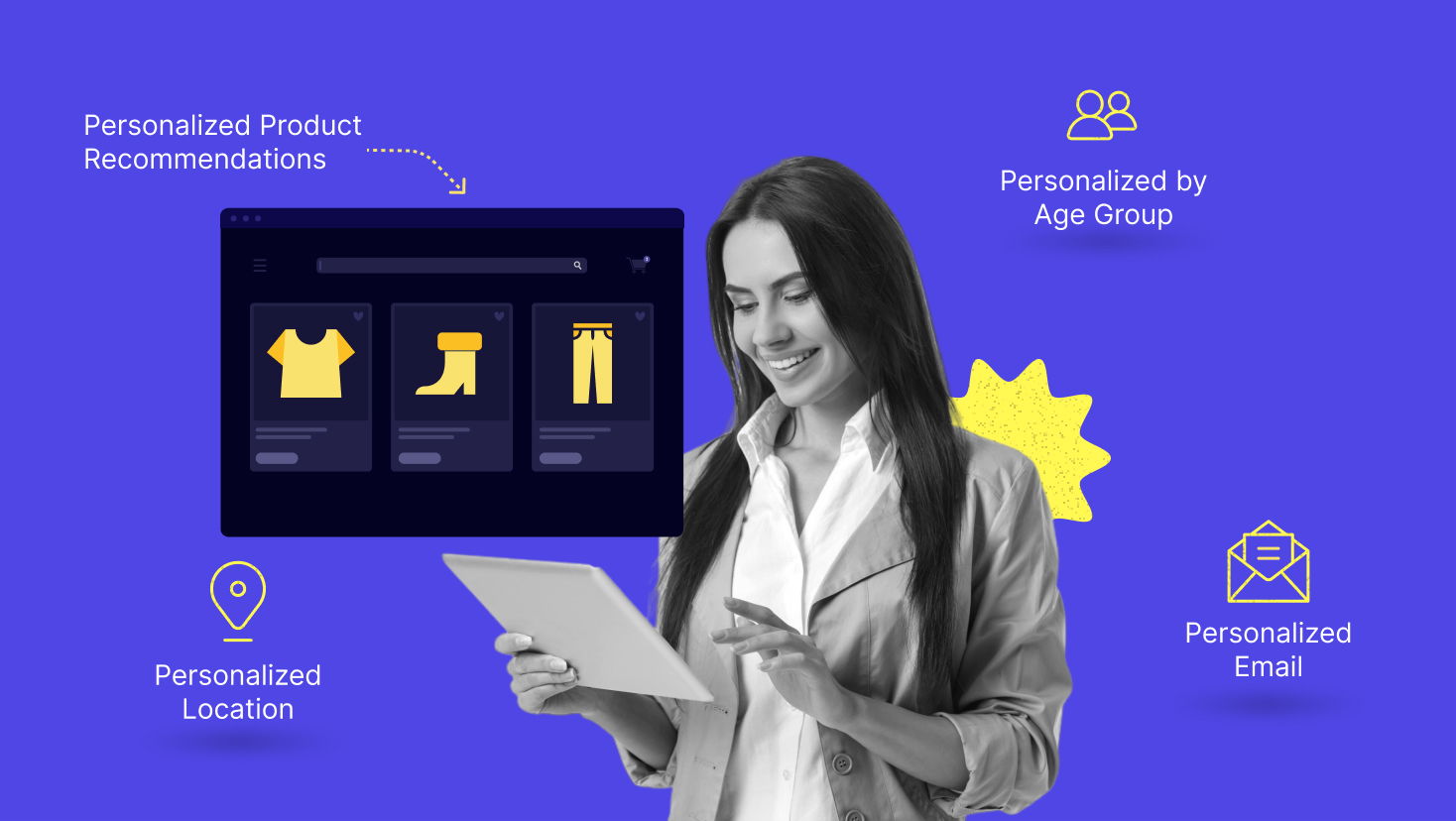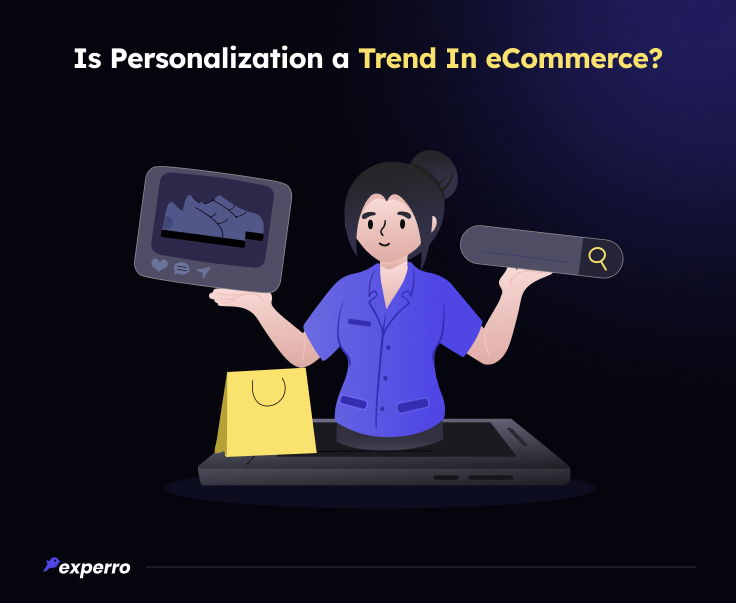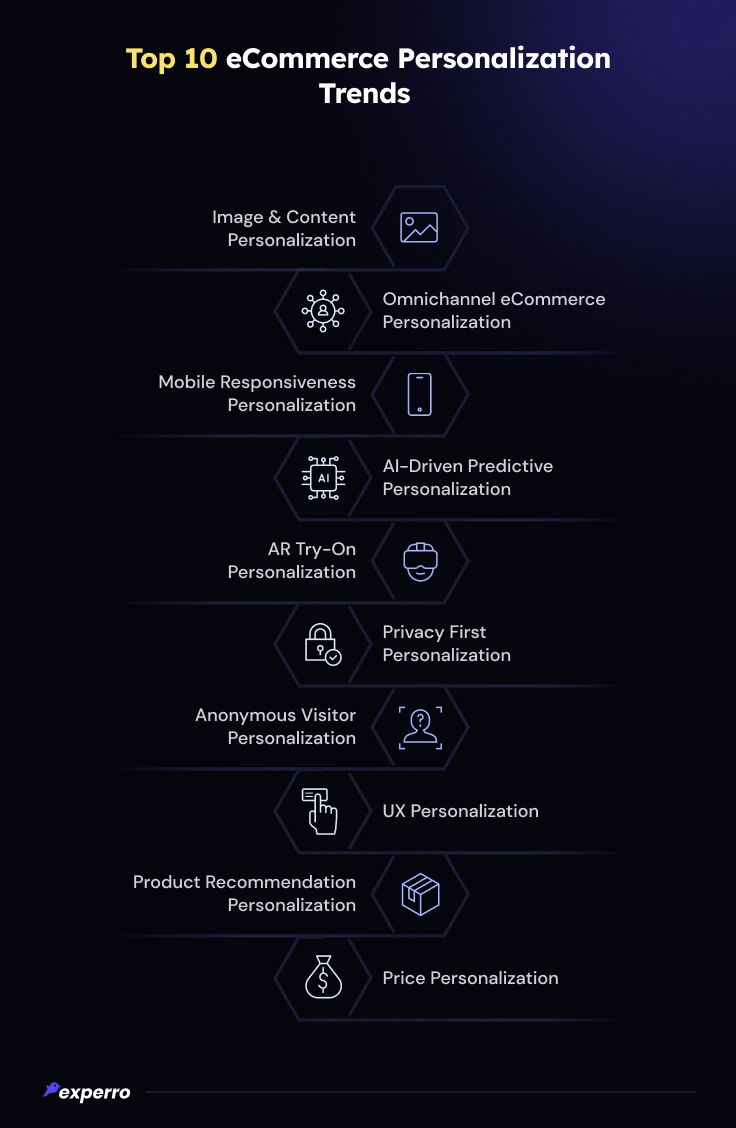Adopt These 10 eCommerce Personalization Trends in 2025

What’s Inside
- Is Personalization a Trend In eCommerce?
- What Are the Top 10 eCommerce Personalization Trends?
- What Makes Experro Your Go-To for Retail Personalization Trends?
- Choose Experro to hyper-personalize your customers’ eCommerce experience like never before!
- Conclusion
Key Takeaways
- Personalization is essential in eCommerce to transform customer interactions with tailored experiences.
- AI-driven recommendations, omnichannel strategies, and privacy-first approaches are leading the future of secure, relevant eCommerce personalization.
- Tailored product personalization is the key to enhancing customer engagement and loyalty.
- Experro's headless CMS and AI-powered personalization features help you to position your brand to excel in delivering cutting-edge, personalized eCommerce experiences.
Personalization in retail is no longer just a trend—it's a necessity.
In 2025, eCommerce personalization software is playing a crucial role in driving successful digital sales strategies.
As online shopping becomes more competitive, businesses increasingly focus on delivering highly personalized experiences.
Emerging personalization techniques, such as predictive analytics and real-time customization, are also gaining traction. This exact ability to create highly relevant, engaging experiences is transforming how retailers connect with consumers.
But, there are some ways where personalization has gone wrong for the businesses as they do this without knowledge.
And the right techniques are setting the stage for the future of eCommerce personalization.
By leveraging eCommerce personalization advancements, businesses can foster deeper connections with their target audience.
Is Personalization a Trend In eCommerce?

Imagine browsing a store online and feeling like every product was handpicked just for you. That’s the magic of customer personalization in eCommerce today.
The eCommerce landscape is shifting towards creating uniquely tailored experiences for every shopper.
eCommerce personalization trends, such as AI-driven profile-based recommendations and personalized content are redefining how brands interact with customers.
It’s no longer about mass marketing; it’s about speaking directly to individual needs and preferences. This shift is transforming personalization trends in retail, making it not just an add-on but a core strategy.
The best eCommerce personalization tools and strategies go beyond basic customization—they’re about crafting experiences that resonate on a personal level.
As hyper-personalization with AI and AR trends continue to evolve, retailers who implement them will find themselves ahead of the curve, offering a shopping experience that feels truly personal for the customers.
What Are the Top 10 eCommerce Personalization Trends?
Gen AI for personalization is transforming the eCommerce landscape rapidly. Several key trends are shaping the future of online shopping.

Below are the top 10 emerging eCommerce personalization trends, each offering unique benefits to retailers and consumers alike.
1. Image & Content Personalization
Image and content personalization is a key aspect of modern eCommerce personalization trends.
By leveraging headless personalization, businesses can decouple the frontend presentation from the backend, allowing for the seamless delivery of personalized eCommerce images and content across various platforms and devices.
With headless architecture, retailers can tailor visuals and content to match individual customer preferences.
This dynamic approach is essential as the benefits of personalization in eCommerce continue to evolve, providing a more responsive and user-focused experience.
2. Omnichannel eCommerce Store Personalization
Omnichannel eCommerce personalization ensures a seamless shopping experience across all customer touchpoints.
Whether a customer shops online, in-store, or via mobile, the experience remains consistent and personalized. This trend is vital as consumers increasingly expect (and truly enjoy) a seamless customer journey.
By integrating omnichannel eCommerce personalization, retailers can track customer behavior across channels, enabling more precise targeting and better-personalized customer engagement.
3. Mobile Responsiveness Personalization
With the growing use of mobile devices, mobile responsiveness personalization is becoming essential.
This trend focuses on delivering personalized content optimized for mobile devices, ensuring a smooth and personalized user experience.
Retailers that prioritize mobile-first eCommerce platform can better cater to on-the-go shoppers, increasing satisfaction and conversion rates.
As mobile shopping continues to rise, this trend will be a key component of successful eCommerce personalization strategies.
4. AI-Driven Predictive Personalization
AI-driven predictive personalization is revolutionizing the way retailers understand and engage with customers.
AI can deliver highly accurate recommendations and experiences by profiling and personalization in eCommerce.
Predictive customer analytics enhance customer satisfaction and drive repeat purchases by identifying and offering relevant products at the right time.
As part of the eCommerce personalization trends 2025, AI-driven predictive personalization will continue to gain success, making it essential for modern generative AI in retail strategies.
5. AR Try-On Personalization
AR (Augmented Reality) try-on personalization is one of the most emerging trends in eCommerce personalization.
This technology allows customers to virtually try on products, such as AR try-ons in jewelry, clothing, or other accessories, before making a purchase.
AR try-on personalization enhances the online shopping experience by providing a more interactive and personalized eCommerce experience.
Retailers leveraging this trend can reduce returns and boost customer confidence, leading to higher sales and brand loyalty.
6. Privacy-First Personalization
With increasing concerns over data privacy, privacy-first personalization is becoming a crucial trend. It’s more like the need of the hour!
This approach focuses on delivering personalized merchandising while respecting customer privacy and adhering to data protection regulations.
By implementing privacy-first personalization, retailers can build trust with their customer base, ensuring that personalization efforts do not compromise personal data.
This trend is especially important as customers become more aware of their digital footprints.
7. In-Session Personalization
‘Anonymous visitor personalization’ addresses the challenge of tailoring experiences for users who haven't shared any identifiable information.
An amazing use case – The in-session eCommerce personalization solutions to the cold start problem, using real-time behavioral data to craft relevant content and recommendations for new or anonymous visitors.
By personalizing the experience within the session, retailers can effectively engage potential customers right from their first interaction, increasing the chances of conversion even before personal data is collected.
8. UX Personalization
User Experience (UX) personalization focuses on tailoring the overall website experience to individual user preferences.
This trend involves customizing everything from layout and navigation to content and product displays based on user browsing history and preferences.
This approach in digital experience design is crucial to enhance the personalized UX, making it easier for customers to find what they want, and increasing engagement.
As eCommerce personalization platforms evolve, UX personalization will help you to drive customer satisfaction significantly.
9. Product Recommendation Personalization
Product recommendation personalization is a tried-and-true method for boosting sales and enhancing the shopping experience.
By analyzing customer data, retailers can provide personalized product page suggestions that align with a shopper’s interests and previous purchases.
A recent study says gen AI-powered product recommendations drive up to 31% of eCommerce site revenue. This type of personalization is highly effective in increasing average order value and improving customer journey.
As part of the ongoing trends, eCommerce product personalization will remain a key strategy for retailers looking to personalize their shopping experience.
10. Price Personalization
Price personalization involves adjusting pricing based on customer segments, behaviors, or loyalty status.
This trend allows retailers to offer personalized discounts or dynamic pricing tailored to individual customers.
Price personalization can enhance customer loyalty and increase conversion rates by offering pricing as per their preferred budget.
As one of the best eCommerce personalization strategies, price personalization will continue to gain importance in the competitive retail landscape in the time to come.
Read our detailed blog on eCommerce personalization stats to know more about the importance of personalization and industry insights.
What Makes Experro Your Go-To for Retail Personalization Trends?
Experro is designed for eCommerce businesses that want to lead in personalization. Unlike traditional platforms, Experro:
- helps eCommerce businesses lead in personalization.
- offers seamless headless CMS for better content management.
- helps tailor every interaction to the individual, enhancing the overall shopping experience through AI-powered search and eCommerce merchandising capabilities.
- facilitates customized experiences with eCommerce content personalization.
- supports omnichannel strategies and mobile responsiveness.
By leveraging Experro, you can stay ahead of the latest eCommerce personalization trends in eCommerce, providing a unique and engaging experience that builds customer loyalty and drives sales.
Conclusion
Staying ahead in eCommerce today means using website personalization types and functionalities at every level.
Your business can meet customer expectations head-on by adopting advanced strategies, from data-driven personalization for eCommerce to privacy-first approaches.
The future of eCommerce is more than just selling products—it’s about building connections through personalized shopping experiences. Embracing these digital commerce trends will differentiate your brand and foster deeper customer loyalty.
Ready to elevate your eCommerce experience? Get in touch with us today.
FAQs


Pallavi Dadhich
23 August 2024Pallavi is an ambitious author known for her expertise in crafting compelling content across various domains. Beyond her professional pursuits, Pallavi is deeply passionate about continuous learning, often immersing herself in the latest industry trends. When not weaving words, she dedicates her time to mastering graphic design.